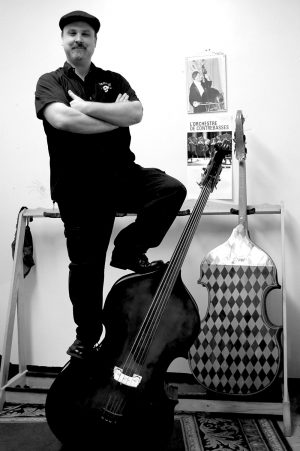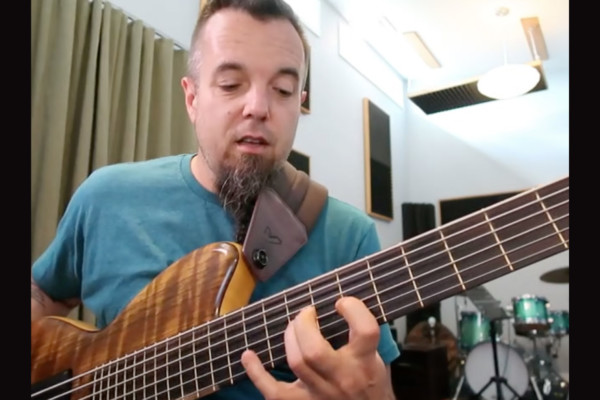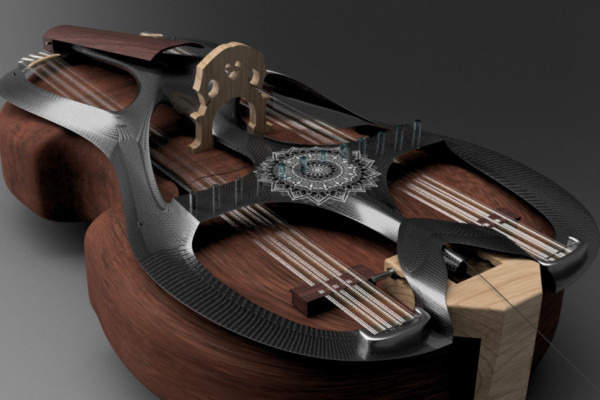My Double Bass Setup: Part 2 – Number of Strings, Tuning and Fingerboard Length
 I play a five-string bass with both a higher string and a low C, via an extension. My specific tuning is (from lowest to highest) C, B, E, A, D. The low C string can be tuned via capos (on the C extension) to any chromatic note between C and E (the more standard low string on a double bass). My highest string (D) is the same pitch as a cello’s open D string. The thin high string, especially, changes the tonal ballgame for the bass.
I play a five-string bass with both a higher string and a low C, via an extension. My specific tuning is (from lowest to highest) C, B, E, A, D. The low C string can be tuned via capos (on the C extension) to any chromatic note between C and E (the more standard low string on a double bass). My highest string (D) is the same pitch as a cello’s open D string. The thin high string, especially, changes the tonal ballgame for the bass.
I didn’t always play a five string, of course, and my solo recording “Gadaha” was done on a four-stringed instrument tuned (C/E, B, E, A) as were some of the Youtube videos which are out there. I used this four-string tuning from the early nineties on. It wasn’t until around 2008 or so that I completed the transition to a five string.
I use this particular setup as it allows me to increase not only the range of my instrument, but its tonal palette as well. As previously mentioned, this is particularly true with addition the high D string.
Other tuning/number of string options that I considered would not give me everything I wanted:
- If I tuned 4 strings in 5ths, with a low C, I would keep the lower range but wouldn’t extend the upper range by much.
- If I tuned 5 strings in 4ths with a low E, I would get a higher range, but not have access to the low C
- If I tuned 5 strings in 4ths with a low C (or B) I would keep the low range, but not have access to an increased high range.
- Of course, if I tuned 5 strings in 5ths I could get the low C and a high E. However, I found tuning entirely in 5ths not compatible with my hand size and the string length of my instrument.
Although I occasionally use other tunings, dependent upon the music, I chose the tuning and setup listed above as my norm for maximum range extension and tonal breadth.
I also have an “extended” fingerboard. It is simply an extra piece of fingerboard attached at the end of a normal fingerboard to lengthen it. While we can play lyrically in the high part of the string without a fingerboard, playing with any speed and clarity is difficult without a fingerboard. Having the extension, allows me to play quicker notes in the highest part of the string.
A standard fingerboard would equate to about 28 frets (if we had frets). Some more modern instruments have boards that would equate to as high as 36 frets. This is a good thing.
My instrument is fitted with a board which equates to about 48 frets for the top three strings, and a bit less for the bottom two. My luthier and I chose to keep the fingerboard shorter on the lowest strings to minimize any muting effect from the addition of the fingerboard extension. I have used some variation of this setup since the early 1990’s, even when I had four strings. Again, the idea has been to extend the range of the instrument.
I think the bass of the future has 5 strings and a longer fingerboard.
Previous: Part 1 – The Bow
Next time: String Spacing and String Height
Dr. Donovan Stokes is on the faculty of Shenandoah University-Conservatory. Visit him online at www.donovanstokes.com and check out the Bass Coalition at www.basscoalition.com.



